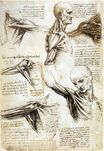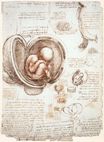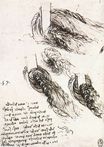Leonardo da Vinci - Portrait of a Bearded Man, possibly a Self Portrait 1513
 |
 |
 |
 |
 |
 |
 |

Portrait of a Bearded Man, possibly a Self Portrait 1513
33x21cm red chalk on Paper
Palazzo Reale di Torino, Turin, Italy
The image is only being used for informational and educational purposes
<< Previous G a l l e r y Next >>
From Wikipedia, the free encyclopedia:
The portrait is drawn in red chalk on paper. It depicts the head of an elderly man in three-quarter view, his face turned towards the viewer. The subject is distinguished by his long hair and long waving beard which flow over the shoulders and chest. The length of the hair and beard is uncommon in Renaissance portraits and suggests, as now, a person of sagacity. The face has a somewhat aquiline nose and is marked by deep lines on the brow and pouches below the eyes. It appears as if the man has lost his upper front teeth, causing deepening of the grooves from the nostrils. The eyes of the figure do not engage the viewer but gaze ahead, veiled by the long eyebrows, with a sense of solemnity.
The drawing has been drawn in fine unique lines, shadowed by hatching and executed with the left hand, as was Leonardo's habit. The paper has brownish "fox marks" caused by the accumulation of iron salts due to moisture. It is housed at the Royal Library (Biblioteca Reale) in Turin, Italy, and is not generally viewable by the public due to its fragility and poor condition. Researchers have developed a nondestructive way to gauge the condition of the drawing by describing and quantifying the chromophores affecting the paper. Their technique, described in Applied Physics Letters (2014), will be used to assess the rate at which the image is deteriorating and should help with planning appropriate conservation strategies.